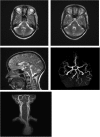Twenty-and-a-half syndrome: a case report
- PMID: 30764883
- PMCID: PMC6376777
- DOI: 10.1186/s13256-019-1980-4
Twenty-and-a-half syndrome: a case report
Abstract
Background: In the list of named numerical neuro-ophthalmological syndromes, such as one-and-a-half syndrome and others, we report for the first time twenty-and-a-half syndrome, which is characterized by one-and-a-half syndrome with bilateral seventh and right fifth nerve palsy (1.5 + 7 + 7 + 5 = 20.5) in a patient with ischemic stroke.
Case presentation: A 45-year-old Asian Hindu woman presented with vomiting and imbalance of 1 day's duration. She had left-sided ataxic hemiparesis with one-and-a-half syndrome with bilateral seventh and right fifth nerve palsy. Magnetic resonance imaging of her brain revealed acute non-hemorrhagic infarct in the right posterolateral aspect of pons and medulla, with normal brain vessels angiography. We described her disorder as twenty-and-a-half syndrome. She was put on antiplatelet therapy.
Conclusions: Twenty-and-a-half syndrome is reported for the first time. It is due to posterior circulation stroke; in our case, it was due to lacunar infarcts in the pons and medulla, manifesting as one-and-a-half syndrome with bilateral seventh and right fifth nerve palsy.
Keywords: Twenty-and-a-half syndrome.
Conflict of interest statement
Ethics approval and consent to participate
We confirm that we have read the journal’s position on issues involved in ethical publication and affirm that this report is consistent with those guidelines. Proper approval and consent was taken from The Sri Aurobindo Medical College and PG Institute’s Ethical committee.
Consent for publication
Written informed consent for publication of this case report and any accompanying images was obtained from the patient. A copy of the written consent is available for review by the Editor-in-Chief of this journal.
Competing interests
The authors declare that they have no competing interests.
Publisher’s Note
Springer Nature remains neutral with regard to jurisdictional claims in published maps and institutional affiliations.
Figures
References
-
- Gotoh F, Tohgi H, Hirai S, Terashi A, Fukuuchi Y, Otomo E, Shinohara Y, Itoh E, Matsuda T, Sawada T, Yamaguchi T. Cilostazol stroke prevention study: a placebo-controlled double-blind trial for secondary prevention of cerebral infarction. J Stroke Cerebrovasc Dis. 2000;9(4):147–157. doi: 10.1053/jscd.2000.7216. - DOI - PubMed
Publication types
MeSH terms
Substances
LinkOut - more resources
Full Text Sources
Medical


